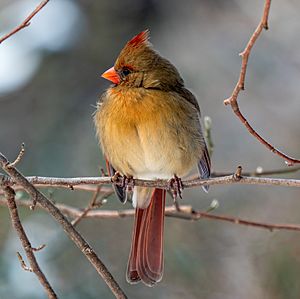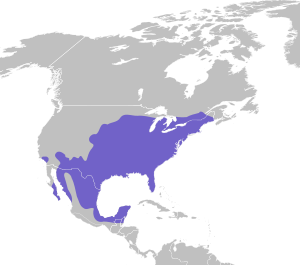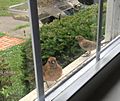Cardinal (bird) facts for kids
Quick facts for kids Cardinal (bird) |
|
|---|---|
 |
|
| Male in New York, United States | |
 |
|
| Female in New York, United States | |
| Conservation status | |
| Scientific classification | |
| Genus: |
Cardinalis
|
| Species: |
cardinalis
|
| Subspecies | |
|
19 subspecies, see text |
|
 |
|
| Approximate distribution map
Year-round |
|
The northern cardinal (Cardinalis cardinalis), often called the redbird or just cardinal, is a popular songbird. You can find it in southeastern Canada, across the eastern and southwestern United States, and south through Mexico, Belize, and Guatemala. It has also been brought to places like Bermuda and Hawaii. Cardinals like to live in woodlands, gardens, bushy areas, and wetlands.
This bird is a medium-sized songbird that perches on branches. It is about 21 to 23 centimeters (8 to 9 inches) long and has a cool crest (a tuft of feathers) on its head. Male and female cardinals look different, which is called sexual dimorphism. Males are a bright red with a black mask around their beak. Females are more of a reddish-brown color with a gray mask. Young cardinals don't have the bright orange-red beak like adults until they are almost fully grown. Their beaks start out grayish-black.
Northern cardinals mostly eat seeds, but they also enjoy insects and fruit. The male cardinal protects his home area by singing loudly. During courtship, the male feeds seeds to the female, beak-to-beak. A female cardinal usually lays three to four eggs at a time, and they can have two to four groups of babies each year. People once kept cardinals as pets, but this was made illegal in the United States by the Migratory Bird Treaty Act of 1918.
Contents
About the Northern Cardinal
What's in a Name?
The northern cardinal was first described by a scientist named Carl Linnaeus in 1758. Its scientific name is Cardinalis cardinalis. It was named after the cardinals of the Roman Catholic Church, who wear special red robes and hats. The "northern" part of its name helps us know it's the cardinal species found furthest north.
Where They Live
Northern cardinals are very common in the eastern United States, from Maine down to Texas. They also live in parts of Canada, like Ontario and Quebec, and south through Mexico. You can also find them in places like Bermuda and Hawaii, where they were introduced. They love living in forests, gardens, and bushy areas.
In the past, cardinals were not as common in some areas, but their numbers have grown a lot since the 1960s, especially in places where there are both dense bushes and open spaces, like parks and suburban neighborhoods.
How They Look
The northern cardinal is a medium-sized songbird. It is about 21 to 23.5 centimeters (8 to 9 inches) long and has a wingspan of 25 to 31 centimeters (10 to 12 inches). An adult cardinal usually weighs between 33.6 and 65 grams (1.2 to 2.3 ounces). Males are usually a little bigger than females.
Colors and Feathers
The adult male cardinal is a stunning bright red. He has a black mask around his eyes that goes down to his upper chest. His back and wings are a slightly darker red. The female cardinal is more of a brownish color, with a bit of red on her wings, crest, and tail. Her face mask is gray to black and not as clear as the male's. Both male and female cardinals have noticeable crests and bright coral-colored beaks. Their beaks are strong and cone-shaped.
Young cardinals look similar to the adult female until they grow their adult feathers in the fall. They are brown on top and reddish-brown underneath, with a brick-colored crest, forehead, wings, and tail. Their legs and feet are dark pink-brown, and their eyes are brown.
The bright red color of the male cardinal comes from special pigments called carotenoids that they get from their food. Sometimes, a rare "yellow morph" cardinal is born. These birds can't change the yellow pigments into red ones, so they have yellow feathers and beaks instead of red.
In winter, cardinals fluff up their soft down feathers to keep warm air close to their bodies. They can also shiver to create heat. If it gets really cold, cardinals can even lower their body temperature a few degrees to survive.
Cardinal Songs
Both male and female cardinals sing clear, whistling songs. They repeat patterns several times and then change them up. Some common songs sound like "cheeeer-a-dote" or "purdy, purdy, purdy."
Cardinals also have a special alarm call, which is a short, metallic chip sound. They often use this call when a predator is near their nest to warn the female and their babies.
Even though humans can't tell the difference, the songs of male and female cardinals are slightly different. This might be because of different hormone levels in their bodies.
What They Eat
Adult northern cardinals mostly eat seeds, grains, and fruits (up to 90% of their diet). They are ground feeders, meaning they hop around on the ground through trees or bushes to find food. They also eat snails and insects like beetles and grasshoppers. Young cardinals are fed almost entirely insects. Cardinals also enjoy corn, oats, sunflower seeds, and even drink maple sap from holes made by woodpeckers.
Protecting Their Home
The male northern cardinal is very protective of his territory. He sings loudly from the top of a tree or another high spot to tell other males to stay away. He will chase off any other males that enter his area. Sometimes, he might even fight his own reflection in a window or mirror, thinking it's another male!
Cardinals learn their songs, so their songs can sound different depending on the region they live in. Mated cardinal pairs often travel together.
Family Life
Cardinal pairs might stay together for many years, but some also find new mates. They generally stay together all year, but they aren't always completely loyal to each other. Studies have shown that some baby cardinals are not fathered by the female's mate.
Before nesting, mated pairs sometimes sing together. During courtship, the male might bring food to the female and feed her beak-to-beak as a way to bond.
The female cardinal does most of the nest building. She crushes twigs with her beak to make them flexible, then turns in the nest to shape it into a cup with her feet. The nest has four layers: twigs, a leafy mat, grapevine bark, and finally soft grasses and pine needles. It usually takes three to nine days to build. A finished nest is about 5 to 7.6 centimeters (2 to 3 inches) tall and 10.1 centimeters (4 inches) across. Cardinals usually don't use the same nest more than once. The female builds her nest in a hidden spot in a dense bush or low tree, about 1 to 3 meters (3 to 10 feet) off the ground.
The oldest wild cardinal ever found lived for almost 16 years! In captivity, one lived for 28.5 years. About 60-65% of adult cardinals survive each year.
-
A young cardinal, called a fledgling, at a feeder
-
A young male northern cardinal (left) at a feeder with a female house finch
Nests and Babies
Eggs
A cardinal nest usually has 3 or 4 eggs, but sometimes there can be 1 to 5. The eggs are white with a hint of green, blue, or brown. They have lavender, gray, or brown spots, which are thicker at the larger end. The shell is smooth and a little shiny. Each egg is about 26 by 19 millimeters (1 by 0.75 inches).
Eggs are laid one to six days after the nest is finished. The female usually sits on the eggs to keep them warm, which is called incubating. This takes about 12 or 13 days. The young birds leave the nest about 10 or 11 days after hatching. Cardinals can raise two, three, or even four groups of babies each year. The male cardinal takes care of and feeds the first group of babies while the female incubates the next set of eggs.

Nestlings
Newly hatched cardinals are very small, weighing about 3 to 3.5 grams (0.1 to 0.12 ounces). They are born without feathers, are blind, and can't move much. They start to grow feathers when they are about 4 or 5 days old. Unlike adult cardinals, baby cardinals eat mostly insects, which their parents crush for them. They gain about 2 to 3 grams (0.07 to 0.1 ounces) each day.
Baby Bird Sounds
Baby cardinals make sounds to get their parents' attention for food. Very young babies will beg if their nest is moved. As they get older, they only respond to their parents being nearby or to their parents' songs.
Cardinal Life in Nature
Who Hunts Cardinals?
Northern cardinals are hunted by many different animals in North America. These include falcons, hawks, shrikes, bald eagles, and several types of owls. Baby cardinals and eggs are often eaten by milk snakes, blue jays, crows, squirrels, and domestic cats.
Sometimes, cowbirds lay their eggs in cardinal nests, tricking the cardinals into raising the cowbird chicks.
Cardinals and People
Northern cardinals are often seen in neighborhoods and backyards. People can attract them by putting out bird feeders with seeds, especially sunflower and safflower seeds. Because more people are feeding birds, the cardinal's range has grown, and there are now about 100 million cardinals in the world. Their numbers seem to be stable or even increasing.
Cardinals were once popular pets because of their bright color and unique song. However, in the United States, it is now illegal to catch, kill, or own northern cardinals. This is thanks to the Migratory Bird Treaty Act of 1918. Breaking this law can lead to a large fine and even jail time. Cardinals are also protected in Canada.
Sports Mascots
In the United States, the northern cardinal is the mascot for many sports teams. You might know the St. Louis Cardinals baseball team or the Arizona Cardinals football team. Many colleges and universities also use the cardinal as their mascot, like Ball State University and the University of Louisville.
State Bird
The northern cardinal is the official state bird for seven U.S. states, which is more than any other bird! These states are Illinois, Indiana, Kentucky, North Carolina, Ohio, Virginia, and West Virginia.
Subspecies
There are 19 different types, or subspecies, of the northern cardinal. Each subspecies might have slight differences in their looks or where they live.
Images for kids
-
A scarlet tanager foraging in a flowering dogwood tree.
See also
 In Spanish: Cardinal para niños
In Spanish: Cardinal para niños
















